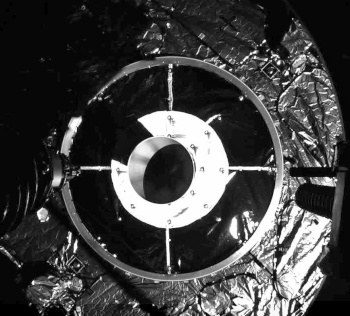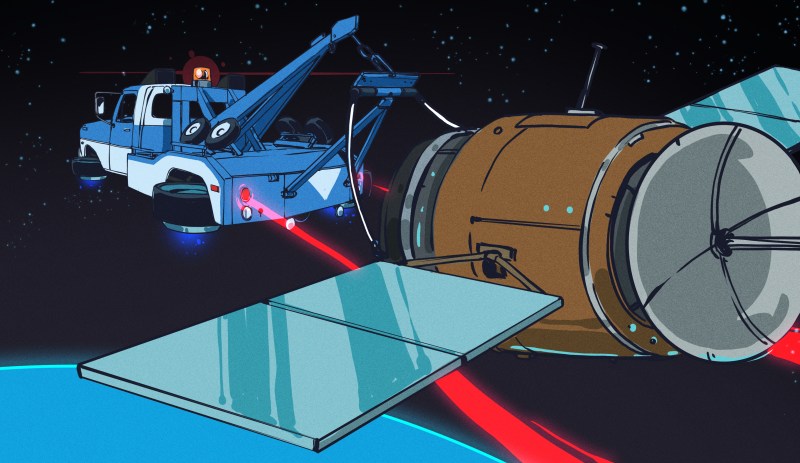In the early days, satellites didn’t stick around for very long. After it was launched by the Soviet Union in 1957, it only took about three months for Sputnik 1 to renter the atmosphere and burn up. But the constant drive to push ever further into space meant that soon satellites would remain in orbit for years at a time. Not that they always functioned for that long; America’s Explorer 1 remained in orbit for more than twelve years, but its batteries died after just four months.
Of course back then, nobody was too worried about that sort of thing. When you can count the number of spacecraft in Earth orbit on one hand, what does it matter if one of them stays up there for more than a decade? The chances of a collision were so low as to essentially be impossible, and if the satellite was dead and wasn’t interfering with communication to its functional peers, all the better.
The likelihood of a collision steadily increased over the years as more and more spacecraft were launched, but the cavalier approach to space stewardship continued more or less unchanged into the modern era. In fact, it might have endured a few more decades if companies like SpaceX weren’t planning on mega-constellations comprised of thousands of individual satellites. Concerned over jamming up valuable near-Earth orbits with so much “space junk”, modern satellites are increasingly being designed with automatic disposal systems that help make sure they are safely deorbited even in the event of a system failure.
That’s good news for the future, but it doesn’t help us with the current situation. Thousands of satellites are in orbit above the planet, and they’ll need to be dealt with in the coming years. The good news is that many of them are at a low enough altitude that they’ll burn up on their own eventually, and methods are being developed to speed up the process should it be necessary to hasten their demise.
Unfortunately, the situation is slightly more complex with communications satellites in geosynchronous orbits. At an altitude of 35,786 kilometers (22,236 miles), deorbiting these spacecraft simply isn’t practical. It’s actually far easier to maneuver them farther out into space where they’ll never return. But what if the satellite fails or runs out of propellant before the decision to retire it can be made?
That’s precisely the sort of scenario the Mission Extension Vehicle (MEV) was developed for, and after a historic real-world test in February, it looks like this “Space Tow Truck” might be exactly what we need to make sure invaluable geosynchronous orbits are protected in the coming decades.
Unexpected Company

On paper, the idea behind the Mission Extension Vehicle is simple. It flies up to a satellite, attaches itself securely to it, and very literally drags it to where it needs to go. In the case of a completely defunct satellite, the destination would be a so-called “graveyard orbit” that will never intersect with another vehicle. If the satellite is just out of propellant but otherwise functional, then the MEV could remain attached to it for the remainder of its mission; taking over the maneuvering and propulsion tasks that the spacecraft could no longer perform on its own.
There’s only one problem with this concept: these satellites were never designed to dock with another spacecraft. In fact, they were never even supposed to come within a 100 kilometers of another vehicle. Between unfurled solar panels and extended antenna arrays, approaching a large communication satellite and trying to capture it is not entirely unlike trying to grab a cactus. The result of anything but the most delicate and accurate handhold is going to be immediately and exceptionally unpleasant.
So where do you even attempt to snag such a satellite? There won’t be a formal docking port or dedicated capture point. Again, this is a vehicle that was launched into space with the assumption that it would operate in total isolation until such time that it was pushed into deep space for all eternity. A convenient carrying handle wasn’t exactly on anyone’s mind while it was being designed.
A Lesson in Satellite Anatomy
With so many different satellite designs in use, and precious few of them being well suited to mid-mission servicing attempts, the engineers behind the MEV had to find some kind of common structural component that could be used as a makeshift grapple fixture. Attaining compatibility with 100% of the spacecraft currently in orbit wouldn’t be possible, but if they could at least make sure MEV was able to snag the majority of targets it ran up against, it would be a step in the right direction.

Somewhat ironically, the perfect grapple point ended up being the part of the satellite that at this point would be otherwise useless: the engine. Nearly every geostationary satellite will have what’s known as an “apogee motor”, a liquid propellant thruster that’s used to put the spacecraft into a circular geostationary orbit after it has separated from the booster rocket that carried it into space.
Not only does the nozzle of this engine make an ideal visual detail to search for on the surface of the target, but the area where it’s mounted to the satellite would have obviously been designed to handle considerable structural loads. In short, the best place to push a satellite is the exact spot where the engineers originally designed it to be pushed.
To firmly attach itself to the engine of the target satellite, the MEV uses an expandable probe not unlike an anchor used to secure a screw into a hollow wall. The probe is carefully inserted down the “throat” of the engine, and then expanded inside of the combustion chamber so that it’s too large to come back out. Damage to the engine seems inevitable with this method, but again, at this point the satellite would have either failed entirely or expended all of its propellants. In either event, the engine was doomed before MEV ever paid it a visit.
All In a Decade’s Work
The MEV is designed to operate for at least 15 years, which Northrop Grumman hopes will allow it to service multiple satellites during its lifetime. In theory it could spend 10 years proving auxiliary propulsion for an elder communications satellite, send it off towards deep space once its replacement was ready, and still have a few good years left in it should another satellite require its services. With a fleet of MEVs, the company could provide orbital “Roadside Assistance” for an entire industry.
To that end, Northrop Grumman chose an excellent candidate for the first mission. Intelsat 901 is a Ku-band satellite launched back in June of 2001 that had recently run low on propellant and moved itself into a graveyard orbit as a precaution. On February 25th, Mission Extension Vehicle 1 (MEV-1) met Intelsat 901 in this orbit and commenced docking operations. The event not only marked the first docking of two commercial spacecraft, but the first time a docking has ever been performed with a spacecraft that wasn’t originally designed with the capability.
Soon, MEV-1 will tow Intelsat 901 back into a standard orbit where it will resume normal operations for five more years. After which, the satellite will be returned to the graveyard orbit and MEV-1 will detach with at least a decade left on the clock. With the ability to extend the lifetime of multiple expensive geosynchronous communications satellites on each mission, the Mission Extension Vehicle promises to be very lucrative endeavor for both Northrop Grumman and its future customers.
















That Joe Kim artwork is truly epic.
They have a theme song already! Rocket Tow Truck by Future Folk
I’ll have to look that one up. I was thinking “Space Truckin” by Deep Purple.
Tom pitched this idea, and we all basically simultaneously said/thought “Imagine the Joe art!”
BTW: Hackaday has copyright, so you can’t use it for commercial purposes, but nobody’s stopping you from downloading the high-res version and getting a poster printed to hang on your wall.
https://hackaday.com/wp-content/uploads/2020/03/Northrop.jpg Just sayin’.
If you do, take a photo and send it to us. :)
Editors, can we have a monthly poster in the store, where readers vote on their favorite artwork of the month?
Given that print to order has been a thing for nearly 2 decades (Or is it slightly over, when was cafepress launched???) I don’t know why they can’t make all artwork available somewhere, mug tee or wallhanger.
I really love this picture too, hackaday has a lot of great artwork lately!
Missing the point here: geostationary satellites are stationary with respect to the sky, so they must be stationary also with respect to one another. How can there possibly be overcrowding of geostationary orbit? You could fill up the whole orbit putting one satellite next to the other (and that’s a LOT of satellites!) Am I missing something?
Since nothing in the real world is actually perfect sphere etc, they do a little dance on station, so need elbow room.
The word is “perturbations.” Small forces not accounted for in the simplistic, two-body, everything runs on ellipses or hyperbolas picture of orbital dynamics. Gravity from the Moon, or Jupiter, or the Sun, or the nonuniformity of Earth, or pressure from sunlight, all nudge those satellites off of their ideal circular paths. They periodically fire thrusters to counteract those perturbations and stay near their assigned positions, but there has to be some allowance for neighboring satellites to do their own thing.
Satellites in geosynchronous orbit are spaced out 1,000 kilometers so they don’t interfere with each other or potentially collide due to some maneuvering error. Since they’re all at the same inclination, that only gives us approximately 1,800 “parking spots” around the Earth. Of those, about 400 are currently in use.
That might sound good, but you have to remember you can’t just drop into one of those spots at random. If I’m an Internet provider that wants to serve North America, then obviously the spots on the other side of the planet don’t do me any good. So there’s considerable competition for prime positions in the ring, and even a handful of dead satellites sitting around up there taking up spots could be a serious problem.
just look up the word geostationary on dockduckgo and everything will be clear. :-)
Frequency reuse is a big problem as well. Certain orbital slots are worth more to providers for the coverage/customers they reach and most satellites are designed with a specific slot in mind. When countries/companies dont communicate with each other you end up with two $300mil satellites parked next to each other and interferring with each other. Then it becomes a pissing contest. Not to mention some operators just arent that good at flying a satellite and they move all over the place.
Also, not all geostationary satellites are in a 0 inclination orbit. Some are intentionally in orbits with a slight inclination to save on fuel.
I worked on a satellite phone system that used one geostationary satellite to project ~400 mile diameter spotbeams on earth (think of them as cell towers). We had to account for the shift in location of the spotbeams due to the intentional inclination of the orbit.
Since this was the largest payload launched to geostationary orbit at the time, I assume a 0 degree inclination orbit would have required reducing the mass of the satellite.
In theory, some inclination to the orbit shouldn’t cause it to cross the path of another satellite, but it’s another thing to account for (and get right)
Right up the ol’e clacker!
Yeah about time upgrading material that’s still operational and needs some controls maintenance. Especially with the passive reflectors I’m thinking.
Anyhow… time for some Space Truckin’:
https://www.youtube.com/watch?v=5hqG-29NTSU
You know… that’s would be bad ass (like really awesome excellent righteous environmentally resourceful to recycle) to tow and load up a return capsule to re-use the material from space that’s higher value asset. Like Green Peace for space with warrior tech!
What high-value materials do you expect to find in a satellite? They’re mostly aluminum, which is dirt cheap. Bit of titanium here and niobium there, maybe a few grams of precious metals in the thruster catalyst beds and gold plating on the electronics. The wire harnesses might be the most valuable part, at least several hundred bucks’ worth of silver plating and copper in there. Dunno what scrap germanium is worth, but there’s under fifty kilos of it in a high-end GEO bird. I doubt the total scrap value would break ten grand, even for a big one.
And the complicated stuff will all be at the end of its design lifepsan — you’re not going to find much demand for a twenty year old computer that’s already irradiated to hell and back, nor the similarly obsolete RF components. The thrusters are nearly burned out; their lifespan was more or less matched to the fuel load. The raw materials in a satellite are mostly pretty mundane stuff — aluminum, copper, teflon, steel, mylar, fiberglass, epoxy, perhaps a surprising amount of kapton tape. The cost in putting one up there is in the design, analysis, assembly, and testing labor.
Recycling the material IN space might be an idea, since it costs a heck of a lot to push anything up there. If for example we developed 3D metal printing that could take chipped waste for input, it might pay to drag a few old birds over to your station, build stuff in place with it rather than lift it all from the bottom of the well.
Given that it wouldn’t be possible (for at least a looong time) to produce an entire satellite in orbit, I wonder how many of them would have to be produced in order to make back the investment in the fabrication satellite.
Most immediately useful is probably recovering solar panels and nuclear-thermal batteries. Who cares if they’re only 10% efficient when they used an acre of them to drive thirsty old 70s chips and they’re already up there.
Since so much of a satellite’s mass is just there to hold the functional bits together through the violence of launch, in-space fabrication with robotic assembly could be a very big deal even if you have to haul all the raw material up. Antenna structures and solar arrays that don’t have to reliably self-deploy after being shaken all to hell, rotating pivots that never even have to bear one whole gee, complex electronic systems that could be launched in padding and plugged together later… There’s a lot of stuff that could be far lighter, simpler, and cheaper.
Wouldn’t that make those space built contraptions even more delicate to handle with that tow truck when they reach the end of their life?
Maybe the dead satellites could be pushed into a Lagrangian point for storage until such time as space recycling is cost effective, basically put them into a space dump. (All depends on how much the dumping could cost of course.)
Or just keep pushing them towards a Lagrangian point until such time as they form a sphere under their own gravity… spare moon in case of accidents.
Time for a “Salvage-1” remake.
+1
And a Quark remake.
Now that’s space cool. Interesting to see such a “straight forward” concept that is just now made possible by technology advances, come into fruition.
Sell the Kepler telescope to a commercial operator and send one of these out to take over for its failed reaction wheels. This is essentially the same idea I’ve been trying to get various people to wrap their brains around ever since Kepler suffered its first reaction wheel failure.
Build it to grab onto the places where Kepler was mounted to its launch rocket. Send up programming to shut down its internal aiming controls and use the addon unit. Some software and procedure changes for pointing the telescope would be needed to coordinate the independent aiming system with the imaging functions of the telescope.
The new owners of Kepler could sell time to companies, educational institutions, and individuals who could never ever afford such deep space observation capabilities on their own.
$10 Plebian supporter level, our thanks on a picture postcard.
$25 Slightly appreciated supporter level, our thanks on a postcard and your name on an SD card that gets vaporised in the rocket pit at launch.
…
And then there’s the old Soviet radar satellites. Rorsat? Initally designed to separate at EOL and have the reactor portion in a stable orbit. As a few folks in Canada may remember, it didn’t always go as planned. And for the fun part, I think someone reported that there were issues with some of parked reactors. Possibly due to leaking sodium coolant I think.
Two interesting issues. The timer used on the Explorer 1 design was built by Bulova watch company here in NYC. It eventually became one of their watches. And Vanguard is still there. It was placed into a perfect orbit in ’58 (or ’57) and as it happens it won’t reenter for another century and a half.
There is only one nice solution to the problem on
How to Recycle 100+ of decomissioned satellites.
Old satellites should get deorbited and send to the Moon, as spare parts mobile stock.
The idea by Grumman
“It’s actually far easier to maneuver them farther out into space where they’ll never return.”
is totally wrong.
Decommissioned satellites should be sent to the Moon as spare parts, metal parts mobile stock
and used in the following years to build Lunar Base
My team can invest time, money and r&d labor in such high-tech No.1 Space Project.
email me if interested to join the team
hfexchange at gmail